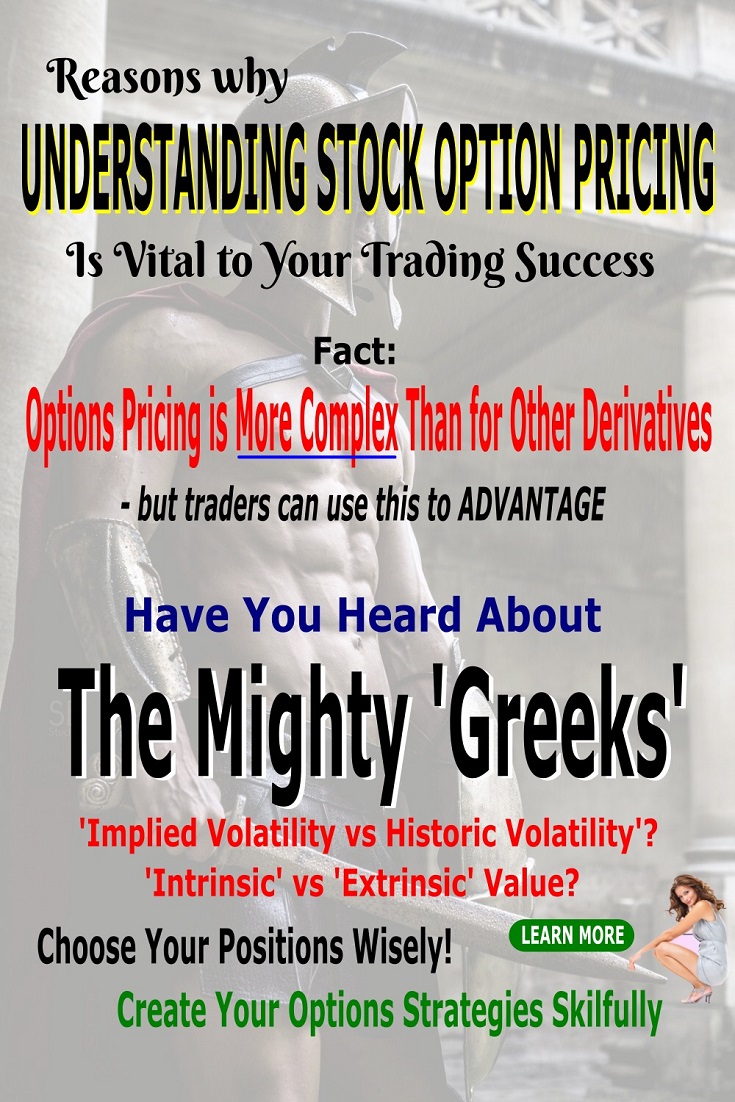Search Options Trading Mastery:
- Home
- Stock Option Trading
- Stock Options Pricing
Stock Option Pricing
Why Understanding Stock Option Pricing is Vital to Success
Stock option pricing is one of those subjects that any aspiring trader should clearly understand before venturing into the world of options trading. Options are not like other derivatives such as futures, spot forex, or contracts for difference, in that their pricing components are much more complex.
So let's explore these components and having done so, see if we can identify how best to make the most of them.
Stock Option Pricing - Intinsic and Extrinsic Values
Let's begin by looking at it simply. When the strike price of a call or put option is in a favorable relationship to the current market price of the underlying stock, it is said to be "in-the-money".
For example, if you had $20 call options and the current trading price of the underlying company stock was $24 then your call options are $4 in-the-money (ITM).
For put options, the price of the stock would need to be $16 to be 'in the money' by the same amount. This $4 is the "intrinsic value" of the options - i.e. the amount they would be worth at option expiration date.
If you owned $20 call options for the above company shares and the market price had fallen from $20 to $16 then because the options have no real value if they were exercised, they are said to be "out of the money".
Now if these same options were trading in the market for $5.35 at any particular time, the extra $1.35 above $4 is known as the "extrinsic value" - often called "time value". It is a monetary value that represents the probability that the options will be in-the-money by expiration date.
The same applies when the option is "out-of-the-money" (OTM). It will have some exchange traded value, but it will all be extrinsic value. Since the further OTM options become, the less likely it is for them to have any intrinsic value at expiration date, this will be reflected in the option's extrinsic value.
The above is a 'broad brush' way of explaining option pricing. There are more specific factors that contribute to an option's value, including "the greeks", option volatility and remaining time to expiration. So let's get into the nitty gritty now ...
Stock Option Pricing - The Greeks
There are five option greeks that mathematically determine an option's price. They are called the delta, gamma, vega, theta and rho.
The Delta measures the change in the option's value in relation to a one point move in the price of the underlying stock. The further in-the-money an option goes, the greater the delta.
At-the-money options usually have a delta of 0.5 for call options or -0.5 for put options. This effectively means that for each $0.10 move of the underlying, the option price will change by $0.05 (or half).
But when the option is, say, $2 in the money, the delta is more likely to be around 0.90. This means "time value" becomes a less significant component for "deep in the money" options.
The Gamma measures the rate of change of an option's delta with respect to a one point move in the underlying. When you buy an option, gamma is positive and when selling (going short) an option, gamma is negative, regardless of whether it's a call or put.
Theta measures how much an option loses its value on a daily basis as the expiration date approaches. Theta increases exponentially the closer you get to expiration.
If you've bought an option, theta tells you how many dollars you lose each day while the underlying price action goes nowhere. This is why simple long positions need to not only be correct with regard to direction but also timing.
The converse applies when you've sold (written/gone short) an option. In this case, theta tells you how much money you make each day while the option remains out-of-the-money.
Knowing how to read the theta in connection with the other "greeks" so that you know when it's necessary to adjust your positions, is the key to making a profit with "short" options positions. This is covered in depth, in the Trading Pro System videos.
The Vega is the most powerful of all the "Greeks". Vega measures the effect of implied volatility on an option's price. If vega is positive then we will gain additional profit for every one point increase in the volatility of the market.
Rhois about how much an option price changes in value as a result of a one point change in interest rates. As such, it is not a significant factor in stock option pricing unless big economic news is about.
Stock Option Pricing - Other Factors
The exchange traded options market is a market in itself, quite distinct from the stock market itself. As such, options are subject to the laws of supply and demand like any other financial instrument.
Options contracts are created by both 'market makers' and traders. If there are plenty of options available to take positions in, the market is said to be "liquid".
If there are not many options to be traded, this may be reflected in the option price. If a lot of people suddenly want the call or put options of a particular stock, this will increase their price - in fact, it will be the implied volatility factor in the option price calculation.
Stock option pricing must also take into consideration whether the underlying stock is going to pay a dividend before expiration date. Before and after the dividend, the option pricing model must reflect the "cum dividend" and "ex dividend" nature of the stock.
Stock Option Pricing for Long and Short Positions
Have you ever bought an option contract then the price of the underlying moves but your option's value hardly changes? This is probably because the implied volatility (IV) in your initial purchase price settled down. In other words, you paid an inflated price for the options thanks to increased demand - and now it has settled back to a level more in keeping with normal stock option pricing models.
Always check the Implied Volatility in the options price and compare it with the Historical Volatility of the underlying asset (stock, commodity, currency) before buying an option.
If you're holding long (bought) option positions, you need to keep an eye on the delta but more so the theta (time decay). Time decay is the element that eats away at options positions where the price action of the underlying doesn't move much.
Option trading strategies such as straddles and strangles are particularly vulnerable to this, so always check the option's theta number before executing these type of trades.
But if you're into range trading strategies such as iron condors and calendar spreads, or short weighted positions such as credit spreads, the theta time decay
works in your favor. It then becomes simply a matter of how long you
hold the position before you exit with a profit - providing the price of
the stock remains away from your short position.
**************** ****************
Return to Stock Option Trading Contents Page
Go to Option Trading Homepage
















New! Comments
Have your say about what you just read! Leave me a comment in the box below.